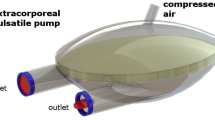Abstract
The “washout effect” inside a blood pump may depend in part on the configuration of the blood pump, including its “port angle.” The port angle, which is primarily decided based on anatomical considerations, may also be important from the rheological viewpoint. In our department, a next-generation diaphragm-type blood pump is being developed. In this study, we examined the influence of the port angle on flow conditions inside our new blood pump. Acrylic resin mock pumps with three different port angles (0°, 30°, and 45°) were prepared for flow visualization. Mechanical monoleaflet valves were mounted on the inlet and outlet ports of the mock pumps. Flow conditions within the mock pumps were visualized by means of particle image velocimetry during a half stroke. As a result, a high flow velocity region was seen along the main circular flow from the inlet to the outlet port. This circular flow was almost uniform and parallel to the plane of the diaphragm-housing junction (DhJ) when viewed from the inlet and outlet sides. Moreover, the proportion of high flow velocity vectors in the plane in the vicinity of the DhJ decreased as the degree of the port angle increased. In conclusion, we found that the flow behavior in the plane in the vicinity of the DhJ changed with the port angle, and that a port angle of 0° may be suitable for our diaphragm-type blood pump in view of the washout effect.









Similar content being viewed by others
References
Meier D, Wernicke JT, Orime Y, Takatani S, Tasai K, Damm G, Naito K, Mizuguchi K, Makinouchi K, Glueck J, Shimono T, Matsuda Y, Ohara Y, Kojima R, Noon GP, DeBakey ME, Nose Y. Flow pattern analysis of the Baylor total artificial heart. Artif Organs. 1994;18:923–32.
Watanabe N, Masuda T, Iida T, Kataoka H, Fujimoto T, Takatani S. Quantification of the secondary flow in a radial coupled centrifugal blood pump based on particle tracking velocimetry. Artif Organs. 2005;29:26–35.
Sakuma I, Tadokoro H, Fukui Y, Dohi T. Flow visualization study on centrifugal blood pump using a high speed video camera. Artif Organs. 1995;19:665–70.
Nakata M, Masuzawa T, Tatsumi E, Taenaka Y, Nishimura T, Tsukiya T, Takano H, Tsuchimoto K, Ohba K. Characterization and optimization of the flow pattern inside a diaphragm blood pump based on flow visualization techniques. ASAIO J. 1998;44:M714–8.
Akagawa E, Lee H, Tatsumi E, Homma A, Tsukiya T, Katagiri N, Kakuta Y, Nishinaka T, Mizuno T, Ota K, Kansaku R, Taenaka Y. Effects of mechanical valve orifice direction on the flow pattern in a ventricular assist device. J Artif Organs. 2007;10:85–91.
Kreider JW, Manning KB, Oley LA, Fontaine AA, Deutsch S. The 50 cc Penn State left ventricular assist device: a parametric study of valve orientation flow dynamics. ASAIO J. 2006;52:123–31.
Oley LA, Manning KB, Fontaine AA, Deutsch S. Off-design considerations of the 50 cc Penn State ventricular assist device. Artif Organs. 2005;29:378–86.
Mussivand T, Day KD, Naber BC. Fluid dynamic optimization of a ventricular assist device using particle image velocimetry. ASAIO J. 1999;45:25–31.
Hochareon P, Manning KB, Fontaine AA, Tarbell JM, Deutsch S. Correlation of in vivo clot deposition with the flow characteristics in the 50 cc Penn State artificial heart: a preliminary study. ASAIO J. 2004;50:537–42.
Tsukiya T, Taenaka Y, Tatsumi E, Takano H. Visualization study of the transient flow in the centrifugal blood pump impeller. ASAIO J. 2002;48:431–6.
Akutsu T, Saito J. Dynamic particle image velocimetry flow analysis of the flow field immediately downstream of bileaflet mechanical mitral prostheses. J Artif Organs. 2006;9:165–78.
Akutsu T, Saito J, Imai R, Suzuki T, Cao XD. Dynamic particle image velocimetry study of the aortic flow field of contemporary mechanical bileaflet prostheses. J Artif Organs. 2008;11:75–90.
Donovan FM Jr. Design of a hydraulic analog of the circulatory system for evaluating artificial hearts. Biomater Med Devices Artif Organs. 1975;3:439–49.
Acknowledgments
This study was partially supported by the Program for Promotion of Fundamental Studies in Health Sciences of the National Institute of Biomedical Innovation (NIBIO) and by a Grant-in-Aid for Scientific Research from the Japan Society for the Promotion of Science (JSPS).
Author information
Authors and Affiliations
Corresponding author
Rights and permissions
About this article
Cite this article
Akagawa, E., Lee, H., Tatsumi, E. et al. Flow visualization for different port angles of a pulsatile ventricular assist device. J Artif Organs 15, 119–127 (2012). https://doi.org/10.1007/s10047-011-0614-4
Received:
Accepted:
Published:
Issue Date:
DOI: https://doi.org/10.1007/s10047-011-0614-4




